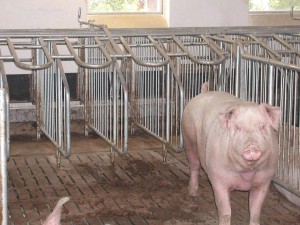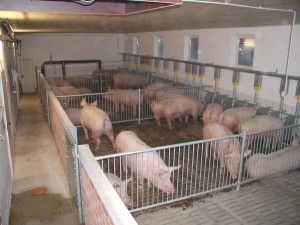Group housing sows in Europe
In the UK all newly weaned and gestating sows have had to be kept in group housing systems since 1999 following a 7 year conversion period. The EU introduced legislation in 2001 that banned the construction of new individual confinement systems from 2003 and will make all existing sow stall housing illegal in 2013.
The UK legislation enforces a ban on confinement (apart from the week pre-farrowing and through to the day of weaning) and is ‘gold plated’ in comparison to the minimum requirements of the EU, which states that all sows must be kept in groups only from the 5th week of gestation up to 1 week prior to farrowing when they can be moved into the farrowing accommodation. Some other EU countries and even federal states within a country have also often ‘gold plated’ the legal requirements well in excess of the basic requirements. Pressure is beginning to build up for a ban on farrowing crates with some UK supermarket chains now demanding that all pig meat should be sourced from herds that do not use confined farrowing facilities.
The good news is that there are now herds operating across Europe achieving in excess of 30 pigs weaned per sow per year using group housing systems and weaning at around 33 days.
The UK’s early conversion, followed closely by its pig meat suppliers Denmark and Holland, has provided some examples of what can be achieved with group housing systems. It has been absolutely clear that the key to any sow housing system is the feeding method employed and in fact there are as many feeding system variants as there are potential housing solutions.
The situation also differs across Europe, with family farms and no employed labour in areas such as western and southern Germany, whilst in the eastern areas of Germany there are larger herds (>300 sows) run entirely with employed labour. The (usually) smaller family farms will probably be considering either to expand or sell up and no longer produce pigs, whilst the larger units with employed labour will be considering the viability of converting relatively large existing slatted floored buildings, albeit often with limited financial reserves and with the need to provide a viable system for 300 or more sows and the employed work force. The solution for a smaller family farm intending to expand will certainly differ considerably from an existing large breeding unit. However, both will have to initially consider the system they will adopt based on the feeding system and whether they will operate a ‘static’ or ‘dynamic’ sow group during gestation.
There has been a trend for larger units to run batch farrowing systems based on farrowing only every third, fourth or even fifth week. This produces very large group sizes and therefore suits the management of the large static groups. The management routine will then operate around weeks where farrowings are planned and other weeks where weaning and mating (usually A.I.) are concentrated. This has implications for the sow housing and farrowing accommodation, as well as the work routine for the animal attendants and management. Management discipline needs to be first rate.
Herds operating a weekly or fortnightly farrowing sequence will often consider either a large dynamic group where animals are added in at weaning or after they are confirmed pregnant (the 5th week), spending this initial period in individual confined housing or small service groups. Static groups are also sometimes built up over several weeks in smaller and medium sized herds with sows added to the group at weaning/mating or once confirmed pregnant. This leads to an increased risk of aggressive behaviour and returns to service.
Where static groups are kept in smaller herds farrowing weekly or fortnightly, then they are often in groups of 4 to 8 sows. A range of systems are commonly used in Europe for such static groups and these include:
Free access feeder stalls with a communal pen, which can be partly slatted or straw bedded. Most countries, or federal states (when applicable) within individual countries, will often insist on the provision of a solid floored bedded area with access to edible/chewable bedding in slatted systems. The sows are usually fed automatically (rationed as a group) with either dry or liquid feed. These facilities will often be fitted into an existing individual stall house or a purpose-built new building. When converting old or existing housing it is important to consider that the overall stocking density may be reduced and in very cold northern parts of Europe supplementary heating is often included, along with modifications to the ventilation system. Straw bedded and part/fully slatted versions are also found.
Kennel systems are also being used increasingly in the colder areas of mainland Europe and these have long been popular in the UK. They are quite simply either individual lying kennels or now, more commonly, small low-roofed insulated kennels or huts (similar to outdoor pig huts) where the sows rest and sleep in small groups. They can be either under a roof or partly in the open, but have natural ventilation. The dunging and exercise yard can be solid or slatted. Huts can have insulated floors without much bedding (some must usually be provided even in slatted housing) or be straw bedded and cleaned out using a tractor/mechanical scraper.
Both of these kennel systems, straw bedded yards and partly slatted environmentally controlled pens, can also be fed in individual feeders (one per sow or on a cafeteria system). These are usually found on existing pig units as they are extremely expensive when built in from new. The individual kennel variant even allows for them to be fed in the individual kennel or cubicle and this is often combined with the daily mechanical removal of solid manure from a solid straw based run.
The “Kombifeeder” is an individual feeder that can be used as a stall for the first 4 weeks of gestation. This approach is favoured on smaller units where they want to ensure the sows do not mix for the first part of gestation when they may still be confined all of the time. Subsequently it can be used as an individual feeder and the sows can lie in them (albeit with no automatic gate at the rear to protect them).
The “Vario-Mix” or “Time-Mix” type feeder has one or more feeding spaces with electronic controlled feeding located in the exercise/dunging area. The feeder drops small portions of feed (usually 20-25g in the case of dry feed or 150g of wet feed) at each drop and can be fitted to feed a small static group of 5 to 8 sows per feeder. The sow triggers either a mechanical or electronic switch and effectively has to root for food. A computer can be used to control the portions and the times the feed is available. This system is found on large herds in Europe (up to 750 breeding sows), but it also fits well into smaller herds. It is best suited for groups of between 5 and 30 sows (1 to 4 feeding points). However, some sows do not respond to these system and these will have to be catered for in alternative accommodation.
Other variants of these feed stations include the tube wet feeder (“Breinuckel”) where the sow is recognized by a transponder and fed according to the ration programmed into the system. The sow only has shoulder barriers for protection and is fed through a metal tube. It is recommended that of these feed stations can provide for a maximum of 18 sows.
The Belados feeder is in effect an electronic feed station without a feeding stall. This is based either on an existing liquid feeding system or alternatively it can be fitted with its own feed and water mixing tank. It is claimed that about 30 sows can be fed per station. These two wet feeding hybrids of the single space and EFS feeder are not yet widely used and experience is limited.
Trickle feeders can also be used with kennels for large and small static groups in straw based or slatted pens in a new or converted building. It is important to ensure that there are about 15% more feeding spaces available than are theoretically required in order to ensure that varying batch sizes can be managed successfully. Not all animals appear to cope with the trickle feeder system, even though the majority do. Some alternative arrangements need to be made for maybe 5% of the gestating herd.
Drop feeders are similar to trickle feeders, except the feed is delivered to all individual animals in one drop from a volumetric hopper or tube. There is also a very effective wet feed variant, the ‘Quickfeeder’ that drops the feed into a trough maintained with a fixed water level. Sows fed wet feed tend to exhibit less aggression during feeding because the slower eating pen mate has a better chance to consume a full ration more quickly, therefore there appears to be a more even intake.
The EFS (Electronic Feeding Station) system is well known and is the feeding method often seen as fitting in best with the so-called dynamic group housing system. These are usually based on large pen variants containing 60 to 200 sows with individual transponders in one dynamic group, with usually 2 to 4 EFS stations. The EFS system can involve a two-pen variant where the sows move from one pen into the other via the feeding station. The sows are moved into the pen that allows entry to the feeder by the opening of a gate once daily (usually first thing in the morning). The advantages are claimed to be less aggression and easier supervision of animals that fail to feed. Gilts are usually either placed into the large dynamic group immediately after first mating or penned separately until after their first weaning. Management and supervision ability and demands must not be underestimated. EFS systems have high maintenance and repair needs and transponders must stay in place for the system to deliver top performance.
Dump or spin feeders are quite popular in the UK, but are almost completely absent on mainland Europe. These can be used to feed both fixed and dynamic groups of various sizes. The pens are usually straw bedded and some EFS users have actually removed their old EFS feeding stations and replaced them with dump or spin feeders. Both of these drop the feed over an area sufficiently large to ensure a reasonably even feed intake. The spin feeder is intended for a larger area and usually for a large group. Despite evidence of good performances achieved by herds using these methods, European advisors and their pig producing customers are concerned about the problems of feed wastage and potential aggression.
Liquid feeding of gestating sows in a long trough with (and even sometimes without) shoulder barriers can also be used for a range of usually small to medium sized static groups. Liquid feeding offers a tremendous advantage in ensuring more even feed intakes and thus maintaining more even sow body condition scores.
Ad-lib feeding of gestating sows, using a high fibre diet, is a recent trend in the Netherlands. Good results are claimed for this approach for both static and dynamic sow housing systems. They employ ad-lib single space feeders filled automatically. This system demands low nutrient density high fibre rations that match the sow’s voluntary feed intake with her nutrient needs. Unfortunately, these special feeds cannot be formulated economically in many areas of Europe as they are based on high fibre raw materials not universally available.
Neville Beynon is a UK-based consultant who works extensively in continental Europe
Photo captions:
- Kombifeeder – The Kombifeeder is an individual feeding stall that can be used as a confinement stall for the first 4-5 weeks of gestation
2. Quickfeeder – The Quickfeeder drops liquid feed into a trough that contains a fixed level of water











